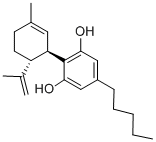CANNABIDIOL

- CAS No.
- 13956-29-1
- Chemical Name:
- CANNABIDIOL
- Synonyms
- CBD;CBD Isolate;CBD oil;cannabidiol (CBD);(-)-Cannabidiol;CBD isolate powder;2-[(1R,6R)-3-METHYL-6-(1-METHYLETHENYL)-2-CYCLOHEXEN-1-YL]-5-PENTYL-1,3-BENZENEDIOL;C07578;CANNABIDIOL;CBD crystal
- CBNumber:
- CB7673434
- Molecular Formula:
- C21H30O2
- Molecular Weight:
- 314.46
- MOL File:
- 13956-29-1.mol
- MSDS File:
- SDS
- Modify Date:
- 2024/12/18 14:08:57
| Melting point | 62-63°C |
|---|---|
| alpha | D27 -125° (0.066 g in 5 ml 95% ethanol); D18 -129° (c = 0.45 in ethanol) |
| Boiling point | bp2 187-190° (bath temp 220°); bp0.001 130° |
| Density | d440 1.040 |
| refractive index | nD20 1.5404 |
| Flash point | 11 °C |
| storage temp. | 2-8°C |
| solubility | Soluble to 75 mM in ethanol and to 75 mM in DMSO |
| form | powder |
| color | White |
| InChIKey | QHMBSVQNZZTUGM-ZWKOTPCHSA-N |
| LogP | 6.600 (est) |
| EPA Substance Registry System | 1,3-Benzenediol, 2-[(1R,6R)-3-methyl-6-(1-methylethenyl)-2-cyclohexen-1-yl]-5-pentyl- (13956-29-1) |
SAFETY
Risk and Safety Statements
| Symbol(GHS) |    GHS02,GHS06,GHS08 |
|---|---|
| Signal word | Danger |
| Hazard statements | H225-H301+H311+H331-H370-H301-H311-H331 |
| Precautionary statements | P210-P260-P280-P301+P310-P311 |
| Hazard Codes | F,T |
| Risk Statements | 11-23/24/25-39/23/24/25 |
| Safety Statements | 36/37-45-16-7 |
| RIDADR | UN 1230 3/PG 2 |
| WGK Germany | 1 |
| RTECS | VH1600000 |
CANNABIDIOL Chemical Properties,Uses,Production
Chemical Properties
Off-White Solid
Uses
Major non-psychoactive constituent of Cannabis. Exhibits multiple bioactivities including anticonvulsant, anxiolytic and anti-inflammatory effects. The (+)-isomers were more active than the (-)-isomers.
Definition
ChEBI: An cannabinoid that is cyclohexene which is substituted by a methyl group at position 1, a 2,6-dihydroxy-4-pentylphenyl group at position 3, and a prop-1-en-2-yl group at position 4.
Biological Activity
Non-psychotropic constituent of cannabis that is anticonvulsive, antihyperalgesic and neuroprotective in vivo . GPR55 and weak CB 1 antagonist (IC 50 values are 0.445 and 3.35 μ M), CB 2 receptor inverse agonist and inhibitor of anandamide uptake (IC 50 = 27.5 μ M). Also a weak agonist at VR1 vanilloid receptors (EC 50 = 3.5 μ M).
Pharmacology
Cannabidiol, a constituent of the cannabis plant, has been receiving considerable attention of late for its potential therapeutic utility, including potential anxiolytic, anticonvulsant,anti-inflammatory, and neuroprotective effects. Cannabidiol has a complex pharmacology. In contrast to THC, cannabidiol has minimal affinity for CB1 and CB2 receptors and produces no intoxication. The effects of cannabidiol in combination with THC have been mixed, with some data suggesting it may reduce THC’s mood-altering and cognitive effects, while others show no effect. If oral cannabidiol reduces cannabis intoxication, it could be a potential medication to treat CUD. However, Haney et al. tested a range of cannabidiol doses (200–800 mg) in combination with active and placebo cannabis and found no cannabidiol effect on the subjective, reinforcing, or cardiovascular effects of smoked cannabis, providing little support for cannabidiol’s utility as a medication to reduce cannabis’ positive reinforcing and subjective effects.
CANNABIDIOL Preparation Products And Raw materials
Related articles
- The Synthesis and Applications of Cannabidiol
- Cannabidiol, is a naturally occurring compound derived from the Cannabis sativa plant.
- Mar 5,2024
- Cannabidiol: pharmacology, clinical applications and toxicity
- Cannabidiol is a non-psychoactive compound from cannabis, effective in treating epilepsy, chronic pain, and anxiety.
- Sep 26,2023
- Introduction of CANNABIDIOL
- Cannabidiol is a chemical in the Cannabis sativa plant, also known as marijuana or hemp. Over 80 chemicals, known as cannabino....
- Aug 15,2019





